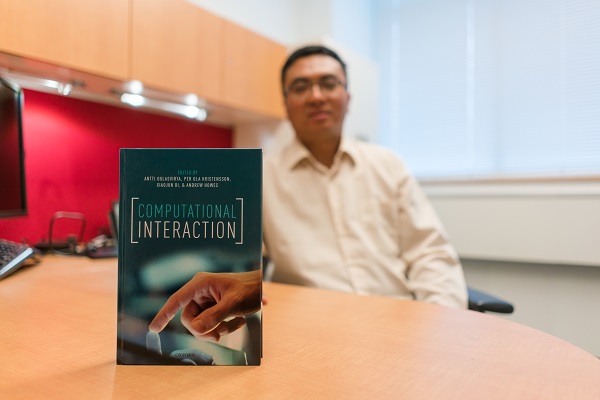 Humans are interacting more and more with technology as it advances through time. Thanks to research that attempts to formally represent a design space, individuals are able to understand the structure of computational interactions and find solutions using desirable properties.
Humans are interacting more and more with technology as it advances through time. Thanks to research that attempts to formally represent a design space, individuals are able to understand the structure of computational interactions and find solutions using desirable properties.
Computer science professor Xiaojun Bi, is one of four co-editors and a co-author for the newly released book, Computational Interaction This book provides a fresh perspective on the way humans and computers interact with one-another, along with presenting a new systematic engineering approach to the design of user interfaces.
“It was really a pleasure to help write this book,” said Bi. “My hope is that students and teachers alike will learn about everything from layout optimization to economic models of interaction and more.”
Professor Bi’s main section in the book, Soft Keyboard Performance Optimization”, introduces the challenges, methodologies and results of keyboard performance optimization to the readers. By using the Metropolis random walk algorithm and Pareto
multi-objective optimization method, they optimized the keyboard layout and a soft keyboard decoder. As the chapter introduction states, “The optimization led to layouts that shorten finger travel distance and improve the input speed as well as accuracy over the Qwerty layout, and a soft keyboard decoder with improved correction and completion ability.”
In discussing soft keyboard performance optimization, Bi covers layout optimization for tap typing. Then progresses to the same for gesture typing before moving onto decoding algorithm optimization. Bi also discusses in his chapter the results of each of his optimization methods, along with the results. Finally, he talks about future work that can be done in this field, something he is quite proud of and excited to share with Stony Brook students.
Bi worked on the book with co-authors and editors Antti Oulasvirta (Aalto University), Per Ola Kristensson (University of Cambridge), and Andrew Howes (University of Birmingham. It is essential reading for students and researchers interested in exploring a range of computational interaction strategies and techniques.
About the Researcher:
Xiaojun Bi is an assistant professor at Stony Brook University’s Department of Computer Science. His research lies in human computer interaction, with a focus on computational interaction especially on Post-PC computing devices. He is a two-time Google Faculty Research Award winner (2016 and 2017), and won ACM CHI Honorable Mention Award three times in the past four years (2015, 2017, and 2018), in 2018 notably for his paper which outlined the design, decoding algorithm and implementation for WrisText, a system that allows users to enter text on smartwatches via wrist gestures. He was also the recipient of the 2013 Google Most Influential Paper Award. Before coming to Stony Brook, he was a Research Scientist at Google. This spring Bi is teaching CSE 594-Advanced Topics in Human Computer Interaction.
- Joseph Wolkin
- Gary Haireti, photo credit
